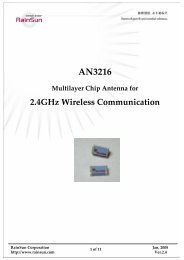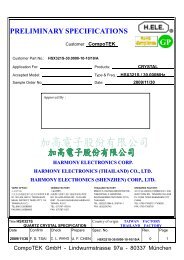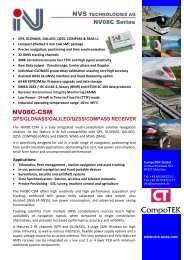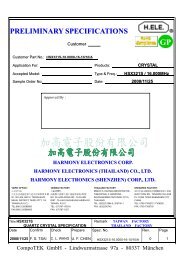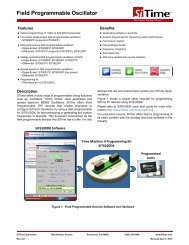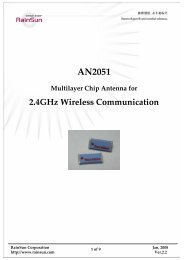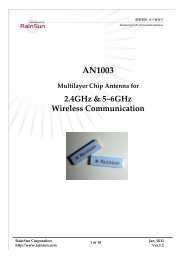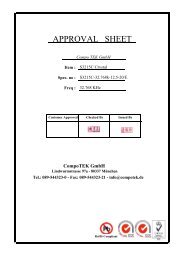A Miniature YIG Tuned Oscillator/Frequency Divider ... - Vida Products
A Miniature YIG Tuned Oscillator/Frequency Divider ... - Vida Products
A Miniature YIG Tuned Oscillator/Frequency Divider ... - Vida Products
You also want an ePaper? Increase the reach of your titles
YUMPU automatically turns print PDFs into web optimized ePapers that Google loves.
VI. CLOSED LOOP OSCILLATOR PERFORMANCEBy closing the ring oscillator’s loop, it is possible tosimulate the YTO’s power output, waveform and phase noiseover a range of frequencies. According to Hajimiri and Lee [2]it is very important for ring oscillators to maintain a highlysymmetric output waveform in order to keep to a minimumthat portion of the phase noise caused by up converted 1/fnoise. Since HBT devices generate very little 1/f noise due totheir bulk effect structure, a highly symmetric waveformprovides double protection against 1/f 3low frequency phasenoise associated with the up converted 1/f noise. Simulationsindicate a nearly sinusoidal waveform over a wide range ofoperating frequencies.Strong oscillations are predicted by simulation to occur inthe octave from 7 GHz to 14 GHz., with power output inaccess of +10 dBm. Under closed loop conditions, thesimulated phase noise at 12 GHz is less than –125 dBC per Hzat 100 KHz, which is a 10 dB improvement over mesfet YTOsoperating at this frequency.Measured power from 7 GHz to 14 GHz is about +10 dBm,in agreement with simulations. The center frequency of theYTO’s tuning bandwidth may be adjusted inversely with stublength. The measured phase noise at 12 GHz is –125 dBC perHz at 100 KHz offset, in close agreement with simulations.Following the YTO with a divide by 4 digital IC divider, themeasured phase noise at the divided frequency (3 GHz) is –137 dBC per Hz at 100 KHz offset, in almost perfectagreement with the 20Log(N) phase noise reduction rule forfrequency dividers. A graph of measured phase noise for boththe fundamental oscillations at 12 GHz, and the divided by 4signal at 3 GHz are shown in Fig. 2. The phase noise deltabetween the two signals is in excellent agreement with20LOG(4)=12 dB.VII. CONCLUSIONSThe YTO reported in this paper represents a significant stepforward in <strong>YIG</strong> source technology. By combining a ringoscillator topology with GaAs/InGaP HBT device technology,plus a miniature <strong>YIG</strong> filter, the new oscillator to be describedin this paper is capable of operating well into Ku band at itsfundamental frequency with superior phase noise and poweroutput. By using a frequency divider IC, to divide the YTO’sfundamental output frequency by a integer N, the samepercentage tuning bandwidth is maintained at the lowerfrequencies while the phase noise is reduced by a factor of20Log(N). Also, because the oscillator’s circuit elements arevery forgiving, alignment labor is kept to a minimum,translating into efficient, lower cost of manufacturing.REFERENCES[1] A A Sweet “MIC and MMIC Amplifier and <strong>Oscillator</strong> CircuitDesign” Artech House, Boston, 1990 .[2] A Hajimiri and T H Lee, “A General Theory of Phase Noise inElectrical <strong>Oscillator</strong>s” IEEE Journal of Solid-State Circuits, Vol.33, No.2, February 1998.[3] T Nguyen, “System based RF amplifier design” Wireless designand development, October 2005.[4] M S Keshner “1/f noise” Proceedings of the IEEE, 70(3): 212-218,1982Fig. 1 Block diagram of Ring <strong>Oscillator</strong> and Divide by N ICFig. 2 Phase noise before and after dividing by 4 (3 GHz)3



